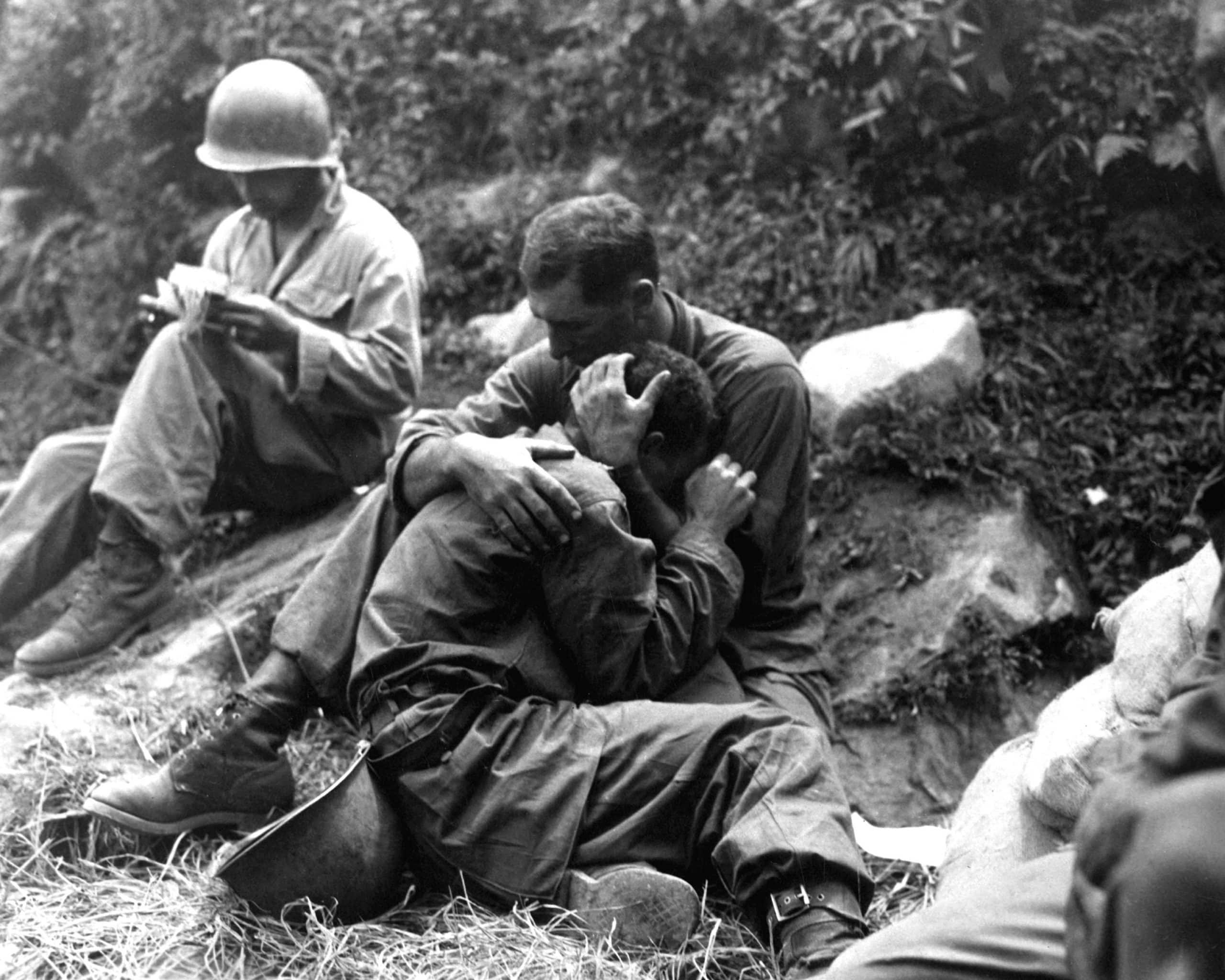In 1996 Lt. Col. Dave Grossman authored “On Killing,” a seminal study on “the psychological cost of learning to killing in war and society.” In it, Grossman documents the unheralded history of man’s inherent resistance to taking fellow human life. This history is so concealed that some, such as philosopher-psychologist Peter Martin have called it “a massive unconscious cover-up.”1
Indeed, despite the near universal glorification of combat across human society, the threads of this hidden truth are everywhere.
For instance, Grossman recites a well-documented study of Prussian infantry accuracy and firing rates. This study found that, using smoothbore muskets, Prussian infantry scored “25 percent hits at 225 yards, 40 percent hits at 150 yards, and 60 percent hits at 75 yards when firing at a 100-foot by 6-foot target.”
Grossman concludes:
[t]hus, at 75 yards, a 200-man regiment should be able to hit as many as 120 enemy soldiers in the first volley. If four shots were fired each minute, a regiment could potentially kill or wound as many as 480 enemy soldiers in the first minute.2
With these established accuracy numbers, casualty rates in that era should have been near one hundred percent, given that, for instance, the average American Civil War engagement took place at “thirty yards.” Conversely, death rates in that war were as low as “one to two men per minute.” Engagements lasted for hours.3 An examination of accuracy rates across a number of contemporary conflicts corroborates these results.4
Evidence suggests that instead of shooting the enemy, most men busied themselves with other tasks, such as tending the wounded, loading weapons (sometimes repeatedly without firing), shouting orders, wandering around, and even finding a discreet place to lay down. Those “few” who did fire their weapons purposely missed their targets. A very select few shot to kill.5
Sources suggest this “problem” existed during World War I as well:
Colonel Milton Mater served as an infantry company commander in WWII…Mater[] provides us with several instances in which World War I veterans warned him to expect that there would be many nonfirers in combat.
When he first joined the service in 1933, Mater asked his uncle, a veteran of World War I, about his combat experience. “I was amazed to find that the experience foremost in his mind was ‘draftees who wouldn’t shoot.’ He expressed it something like this: ‘They thought if they didn’t shoot at the Germans, the Germans wouldn’t shoot back at them.’”6
Citing a host of other historical examples,7 Grossman concludes:
There is ample indication of the existence of the Resistance to killing and that it appears to have existed at least since the black powder era. This lack of enthusiasm for killing the enemy causes many soldiers to posture, submit, or flee, rather than fight; It presents a powerful psychological force on the battlefield; And it is a force that is discernible throughout the history of man. The application and understanding of this force can lend new insight to military history, the nature of war, and the nature of man.8
In fact, according to Grossman’s theory, a crucial element in the success of dominant military forces throughout history is the degree to which their natural resistance to killing was suppressed, intentionally or unintentionally. Nearly all these factors involve decreasing the amount of empathy individual soldiers feel for the enemy.9
One of the first crew served weapons was the chariot. Usually manned by a crew of two—a driver and an archer—the moral responsibility for killing was divested enough to increase its combat effectiveness over regular infantry and cavalry. Chariots were usually manned by aristocracy—the difference in social strata also helped eased the lethality of its operators. Because of these elements, the chariot was a dominate force on the battlefields of antiquity.10
For Alexander the Great, it was the use of the phalanx that allowed diffusion of moral culpability from individual soldiers to the killing unit. What moral culpability remained was spread amongst the tightly packed blocks of soldiers. Close surveillance by unit leaders and comrades assured against eleventh-hour conscientious objection. Long pikes and spears lengthened the intimate killing distance, thus making the killing act more palatable. These factors combined with the synchronized combat movements of the phalanx to “effectively turn the unit into a crew served weapon.” It was highly effective in its time.11
In a similar effort to increase the range of combat, Roman infantry used the pilum, a type of javelin which was hurled at the enemy before close engagements. The purpose of the pilum was twofold, first to weigh down the shields of enemy infantry and second to shock the enemy during a charge by impaling its soldiers with long wooden spears.12
When early Roman battles were all but lost, Roman Triarii, the most wealthy and veteran infantry, replicated the Greeks by forming a phalanx of spears. Assembled in this formation, they became a de-facto crew served weapon. These hardened soldiers were efficient killers.13

https://m.media-amazon.com/images/I/A1qwrIOkLYL._AC_SL1500_.jpg
By all accounts, the majority of killing on ancient and modern battlefields occurs when the enemy routs. When the enemy has its back turned, the pursing and victorious soldiers need not look the enemy in the eye while slaughtering them.
In modern warfare, the introduction of artillery and squad machine gunning gave soldiers the same diffusion of responsibility as the chariot and phalanx. Eventually the use of high-altitude bombing runs and long-distance artillery allowed soldiers to kill on an industrial scale. This was achieved by combining the crew served weapon with the extended combat distance.
In 1945, this psychology allowed bombers to obliterate Hiroshima and Nagasaki, two single acts that slaughtered a combined 129,000-226,000 civilians.
Despite the horrific killing that took place in both World Wars, it wasn’t until after World War Two that the U.S. military consciously recognized the issue the Romans found and treated centuries before: its soldiers were hesitant to kill.14
This, as Grossman recounts, was apparently a serious problem for the Romans. Roman tactician and historian Vegetius “emphasized this point at length in a section entitled ‘Not to Cut, but to Thrust with the Sword:’”
They were likewise taught not to cut but to thrust with their swords. For the Romans not only made jest of those who fought with the edge of that weapon, but always found them an easy conquest. A stroke with the edges, though made with ever so much force, seldom kills, as the vital parts of the body are defended by the bones and armor. On the contrary, a stab, though it penetrates but two inches, is generally fatal.15
After World War Two, the U.S. military became acutely aware of man’s inherent resistance to killing. It at once looked to replicate the methods used across military history to overcome this resistance.
General S.L.A. Marshall’s now infamous study published in “Men Against Fire” concluded that “[o]f every hundred men along the line of fire during the period of an encounter, an average of only ‘15 to 20 would take any part with their weapons.’ This was consistently true ‘whether the action was spread over a day, or two days or three.’”16
Some have disputed the results of Marshall’s study, concluding that it did not muster sufficient scientific rigor.
To this, Grossman writes:
Marshall was the U.S. Army historian in the Pacific theater during World War Two and later became the official U.S. historian of the European theater of operations. He had a team of historians working for him, and they based their findings on individual and mass interviews with thousands of soldiers in more than 400 infantry companies, in Europe and in the Pacific, immediately after they had been in close combat with German or Japanese troops. The results were consistently the same: only 15 to 20% of the American Rifleman in combat during World War Two would fire at the enemy. Those who would not fire did not run or hide in many cases they were willing to risk great danger to rescue comrades, get ammunition, or run messages, but they simply would not fire their weapons at the enemy even when faced with repeated waves of Banzai charges.17
This resistance to killing is clearly not an issue of courage.
Regardless of whether Marshall’s study withstands strenuous scientific rigor, the U.S. military clearly took it seriously.
To combat these low firing rates, U.S. Military introduced Pavlovian and Skinnerian conditioning.18 The primary methods for achieving this end were reflexive fire training and desensitization exercises.
Instead of benign circular targets, the U.S. Military began using targets shaped like human silhouettes. Grunts are now trained to kill these targets within the first milliseconds they pop up on the range. Once hit, the targets fall to the ground, providing realistic feedback. Sometimes the targets are even filled with red paint to more accurately simulate the kill. Grunts with good firing rates receive positive reinforcement by way of praise, marksmanship badges, three-day passes, and other rewards.
The modern grunt is further desensitized through basic training by being made to yell and sing grotesque slogans such as:
Blood makes the green grass grow
Kill, kill, kill
oh ahh, I wanna slap your momma, ooh ahh, I wanna slap your daddy, beat ‘em with a stick, beat ‘em with a stick, oh ahh19
I wanna Rape, Kill, Pillage n’ Burn, annnnn’ eat dead Baaa-bies, I wanna Rape, Kill, Pillage n’ Burn…20
As absurd and comical as some of these efforts may seem, they are nonetheless effective. Firing rates in the Korean War jumped to fifty-five percent. In the Vietnam War firing rates climbed to ninety-five percent.21 Nonfiring in combat is no longer an observed issue in the U.S. Military.22
The subject of killing in war has largely been unexplored by the libertarian community, at the very least in its relation to the morality of war. Most who have studied the topic in depth are military or working with the military.23 To the writer, their inquiry seems to be threefold: (1) “Why Can’t Johnny Kill,”24 (2) “How can we make Johnny Kill,” and (3) “how do we put Johnny back together again after killing (and get him back to the front)?”
A focus on these objectives leaves major gaps in more important inquiry like:
- How do we prevent moral injury?
- What is the relationship between this resistance to killing and moral injury?
- Where does this resistance come from?
- What does the presence of this resistance say about the nature of war itself?
- Does the morality of a particular conflict affect the rate of moral injury amongst those waging it, and, if so, what does an increase of moral injury in a specific conflict say about that conflict?
“In its most simple and profound sense, moral injury is a jagged disconnect from our understanding of who we are and what we and others ought to do and ought not to do.”25 This disconnect occurs when we inflict, witness, or fail to prevent willful violence on another human being or beings. These experiences change our common understanding about the world—that it is generally a good place where good things are supposed to happen to us and to others. Although moral injury is not unique to the occurrence of war, the exceptional horror of war produces moral injury in abundance. By many accounts, the Terror Wars of the 21st Century produce moral injury in exceptional abundance.

https://spotterup.com/combat-stress-vs-ptsd-how-to-tell-the-difference/
It is a persistent myth that the condition of “war” is a unique circumstance where ordinary morality and legality no longer apply—where it is permissible for ninety per cent of drone strikes to kill bystanders, where killing a child can be justified, and where young men are sent to kill and die by far-removed politicians and an indifferent and apathetic public.
The evidence presented in Grossman’s On Killing suggests there is a strong psychological basis for the proposition that killing is fundamentally wrong no matter the circumstances.26
Indeed, the bounds of moral injury are not limited to the study of psychology.27 Its cumulative study encompasses, inter alia, the fields of psychiatry, theology, philosophy, ethics, and art—all of which definitively evidence the fundamental human aversion to taking human life.
In many ways, this conclusion is self-evident—redundant even. Yet, the killing continues and its trauma ripples across the pond of human experience.
For antiwar veterans and activists alike, the study of moral injury and what Dave Grossman dubs Killology will find ample support, not for enabling men to kill, but for insisting that humanity should embrace its own nature.
Citations
1 Grossman, Dave, On Killing: The Psychological Cost of Learning to Kill in War and Society, Back Bay Books, 1996, pp. 35-36.
2 Ibid.
3 Ibid., 16.
4 Ibid., Chs. I & II.
5 Ibid., 20.
6 Ibid., 27-8.
7Ibid., Ch. II
8 Ibid., 28.
9 Ibid., 153.
10 Ibid., 153.
11 Ibid., 153-4.
12 Ibid., 154.
13 Ibid., 154.
14 Ibid., 121.
15 Ibid., 121.
16 Ibid., 3.
17 Ibid., 3-4.
18 Ibid., 35; As Grossman notes, it is entirely possible that no one intentionally sat down to use operant conditioning or behavior modification to develop a reflexive killing action. He notes in his decades of military experience, he did not hear any drill instructor or officer explicitly state reflexive fire training constituted conscious conditioning.
19 Soldiers of Conscience, Luna Productions, 2007.
20 On Killing, 306-7. (this particular cadence is no longer officially allowed in the U.S. Military).
21 Ibid., XV, 35.
22 Soldiers of Conscience, Luna Productions, 2007.
23 For instance, although Grossman professes to be alarmed by the prevalence of violence in society, he leads a consulting firm he calls Killology. The purpose of this firm is to train law enforcement and military how to kill when required.
24 On Killing, 29, Ch. III.
25 Wood, David, What Have We Done, The Moral Injury of America’s Longest Wars, Little Brown and Company, 2016, p. 8.
26 Although the writer would argue that violence and even killing in self-defense is morally and legally justified, physical revulsion has been observed even in justified killings. A larger discussion is warranted regarding the morality of killing in self-defense and killing in self-defense as an unjust participant in an aggressive war; McMahan, Jeff, Killing in War, Oxford University Press, 2011. All soldiers react to killing differently. For many, a pattern may be observed wherein exhilaration and enjoyment are followed by regret and revulsion. For many soldiers, the revulsion concerns their enjoyment of the killing act. Some soldiers do not have a reaction to killing. The psychological reaction patterns to killing are beyond the scope of this piece.
27 Meagher, Robert Emmet, Killing from the Inside Out: Moral Injury and Just War, 2014, pp. 3-4.








